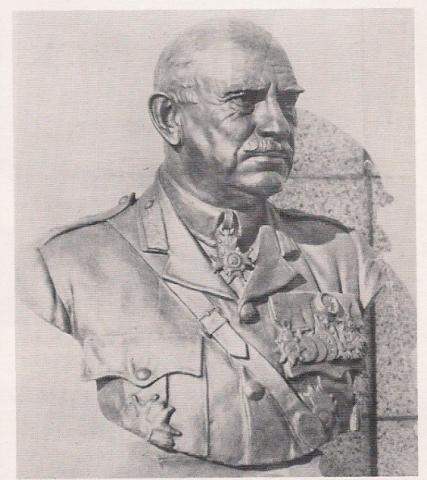SIR JOHN MONASH MEETS MRS ALICE WILSON
Throughout his life, Sir John Monash met a host of dignitaries including King George, Queen Mary, the Prime Minister of Australia (Billy Hughes), Sir Douglas Haig, Rudyard Kipling, Georges Clemencau ( Prime Minister of France), Winston Churchill and the President of USA , Woodrow Wilson. In his travels, Sir John also met Mrs Alice Wilson; however that particular ‘Mrs Wilson’ was no relation of Woodrow.
Alice Wilson was a resident of Yallourn and the honorary secretary of the Housewives’ Association. In 1931, Alice, Mrs Thomas and Miss Rachel Robinson formed a deputation that met with Sir John to discuss matters of importance regarding life in Yallourn. As Meredith Fletcher was later to write…
“..(Alice) formed a deputation to meet with the chairman Sir John Monash, all in an effort to reshape Yallourn to improve living conditions for women and families.” ‘Digging People Up For Coal.’ Page: 74.
The following extract, from ‘The Age’, reports on that meeting; and summarises the discussion that transpired between Sir John Monash and the deputation from Yallourn that day. The newspaper report not only underlines the drive and nerve of Alice Wilson but again reminds readers that Sir John Monash was an extraordinary person with the common touch and empathy for the plight of others. In the book entitled ‘War Letters of General Monash’ an SECV employee, of that era, stated the following about Sir John…
“…the sort of man who would encourage anybody… you could talk to him as though he was your father. He was a very good listener, gave you the impression that you were an important person.” From ‘War Letters of General Monash’ Page: 289.
Time would show how the enduring influence of Sir John Monash transformed a mining camp, not far from the banks of the Latrobe River, into one of the finest ‘garden towns’ in Australia…
“…It was the first town to be planned and built in Australia from scratch, Canberra, planned before Yallourn was built later.” ‘Brown Power’ by Cecil Edwards Page: 67
As is well documented, Yallourn became a cohesive community and Mrs Wilson (and other families) grew to appreciate the town and all it offered for the workers and their families.
_____________________________________________________
AUGUST 5th 1931 ‘ THE AGE’ Page: 10
HOUSEWIVES AT YALLOURN
PROBLEMS DISCUSSED WITH SIR JOHN MONASH
The president of the Housewives' Association (Mrs. W. Thomas), with the organising secretary (Miss R. Robinson) and the hon. secretary of the Yallourn branch of the Housewives' Association, yesterday interviewed the chairman of the Electricity Commission' (Sir John Monash) on matters affecting housewives at Yallourn.
Mrs. Wilson referred to the high rentals operating at Yallourn, and stressed the fact that big reductions had been made in wages, which were expected to result in reductions in rents by the commission.
Reference was also made to extra charges on the houses, which had the effect of increasing the rentals. The question of foodstuffs in relation to prices charged by the commission stores, and the necessity for a regular supply of fish and rabbits, were gone into. In suggesting a reduction in commodities, special reference was made to the price of sugar.
The management of the hospital and other matters were fully discussed.
Sir John Monash expressed sympathy with the deputation and stated he thought much good would result from cooperation between the branch and the commission. He promised that investigation would be made into some of the matters that were brought under his notice.
FOOTNOTES REGARDING MRS WILSON & SIR JOHN MONASH:
1. It is difficult to ascertain where the above meeting was actually held. As the meeting was reported by ‘The Age’ it may have been that Alice, Rachel Robinson and Mrs Thomas had travelled to the city offices of the SECV. There appears to be no local newspaper reports of that meeting.
2. The origins of Victorian Housewives Association can be traced back to 1915. It was originally known as the Housewives Cooperative Association. The Yallourn Branch of the Housewives Association was formed in 1931.
3. Miss Rachel Robinson was a prominent and dedicated official who had held the position of secretary of the Housewives Association for many years.
4. Alice Wilson was said to be the first ‘guider’ when the Girl Guides Association was formed in Yallourn in 1925.
5. In one text, Alice was described as…
“…secretary of everything and a very efficient one too.” ‘Yallourn Was.’ Page: 175.
6. Alice arrived from England in 1924 and had seen Yallourn in its ‘embryonic stage.’ During those harsh times (1920’s and 30’s) for all families of the town, Alice had the courage to speak out and seek change in her quest to improve the living standards of the people of Yallourn.
7. When reading the early newspaper reports of her actions, Alice was ‘no shrinking violet’ in furthering her point of view…
“The same spirited manner and commitment led Alice Wilson to prepare several petitions and take them from door to door raising concerns about the lack of job opportunities for girls in Yallourn.” Meredith Fletcher. ‘Digging People Up For Coal.’
8. In October 1931, Alice Wilson made the news again when she called for a market to be established in Yallourn….
“ MART FOR YALLOURN…that the newly formed Branch of the Housewives Association at Yallourn recently had a conference with Mr Bridges, the General Superintendent at Yallourn, regarding having a Mart at Yallourn, and it is anticipated that the request will be granted. A suitable block of land has been selected. The mart will be held every Friday and will be conducted in the open air for a start. The Association has received a large number of applications for stands.” ‘Morwell Advertiser’ October 30th 1931.
9. According to Meredith Fletcher, Alice Wilson conducted a ‘one-woman campaign’ regarding the continual problem of coal-dust in the homes of Yallourn….
“Alice Wilson, secretary of the Housewives’ Association became so annoyed….that she gathered all the coal dust she had swept off her verandah that day into a parcel and sent it to the general superintendent, with a covering note …” Page: 83.
10. Following a heart attack and a series of strokes, Sir John Monash died, at his home in Toorak, on the 8th October 1931 (at the age of 66). He passed away just two months after his meeting with Alice, Mrs Thomas and Rachel Robinson. It was impossible to unearth a public statement from the Housewives Association regarding the death of Sir John, however at the combined service, at the St John’s Church in Yallourn, to commemorate the life of Sir John Monash, Rev. Bennett stated …
“He (Sir John Monash) was a sympathetic and kind hearted chief, genuinely concerned about the interests of those whose welfare he had accepted responsibility.” ‘Live Wire’ October 15th 1931.
11. Sir John Monash had served as the Chairman of the SECV from January 1921 until his death in 1931. In the SECV’s Annual report in 1931 it was written…
"Victoria’s national scheme of brown coal development and electricity supply is, and will be regarded always as, a monument to his capacity for organization and administration , his amazing industry and his zeal for the public welfare and advancement of the State” November 2nd 1931.
12. History shows that Sir John Monash’s name was one of two considered for the position of Australia’s Governor General in 1930.
(Note: Isaac Isaacs, also Jewish, was appointed to the position in January 1931).
John Monash was a ‘man for all seasons’ and he won respect and deference throughout all tiers of Australian society…
“…a sort of man who appears perhaps once in a generation.” ‘Brown Power’ by Cecil Edwards. Page: 118.
13. Younger readers may be interested to know that the State Funeral (which was held on Sunday 11th October) for Sir John Monash was unique.
Nothing of its kind, had ever been witnessed before; and the funeral was said to be one of the most imposing events ever staged in Australia.
It was the biggest funeral procession in Melbourne’s history and one which brought the city to a complete stop. Estimates put the crowd figure at between 300,000-500,000; and the procession that ‘slow- marched’ to the Brighton Cemetery involved 15,000 members of the armed services. It is documented that many returned soldiers had difficulty in completing the long journey on foot that day. Rabbi Danglow, who assisted in conducting the service that day, paid homage to Sir John by stating…
“A prince and a great man has fallen…We have lost a great national hero, a gallant soldier and pre-eminent citizen. His career began modestly and he grew from strength to strength through his mighty power of intellect and capacity for self-sacrifice and his wonderful powers of concentration. His name will forever live in the hearts of his people.” ‘Monash- The Soldier Who Shaped Australia’ by Grantlee Kieza. ABC Books: 2015. Page: 619
14. In the years that followed Sir John’s death, his name carried a special meaning for the people of Yallourn and the Latrobe Valley. The monument, which was unveiled in the gardens of the Town Square in 1932, was to become a permanent reminder for the residents of Yallourn of Sir John’s vision and intellect.
15. Another story, related to the 1934 Annual General Meeting of the Yallourn Branch of Housewives’ Association, can also be found on this website. Type the words ‘Housewives Association’ into the search field (right hand corner of the screen) and press ’enter.’
16. While life for the families of Yallourn was immensely better in later years, the matter of the price of sugar (see above) was still a vexing topic at the 1939 Conference of the Housewives Association. It is known that Rachel Robinson (see above) attended and spoke in the debate that day. According to the ‘Burnie Advocate’ (Tasmania), she was still secretary in 1950. It is believed that Rachel died in September 1961.
* Apologies for any errors in the transcription of the original article as several paragraphs were damaged with the passage of time and difficult to decipher. (Roger).
This story is part of a history project entitled ‘From the Newspapers’ and a full list of titles in this series can be obtained by contacting Julie George. Julie presented and posted this story on the website while the research and writing were completed by Roger Spaull for the Virtual Yallourn website in April 2017.
The above extract from the ‘The Age’ has been faithfully reproduced. The only amendments to the original copy are the font style, font size and spacing, so as to enhance the story for the purposes of posting on the Virtual Yallourn website.

